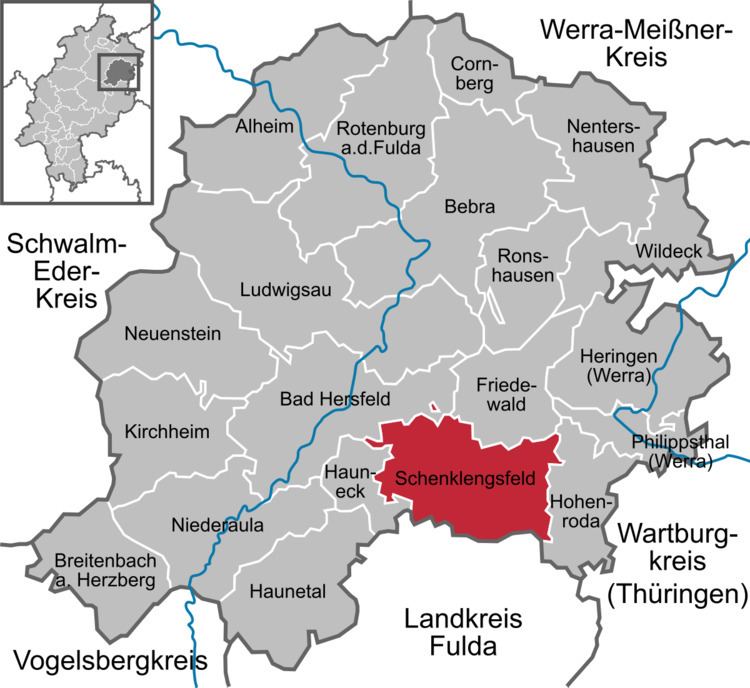Elevation 317 m (1,040 ft) Area 63.78 km² Local time Friday 5:04 AM Dialling code 06629 | Time zone CET/CEST (UTC+1/+2) Population 4,627 (30 Jun 2009) Postal code 36277 Administrative region Kassel | |
 | ||
Weather 6°C, Wind NE at 19 km/h, 83% Humidity | ||
Schenklengsfeld is a community in Hersfeld-Rotenburg district in eastern Hessen, Germany lying roughly 30 km northeast of Fulda and 60 km southeast of Kassel.
Contents
- Map of Schenklengsfeld Germany
- Location
- Neighbouring communities
- Constituent communities
- History
- Amalgamations
- Community council
- Mayors
- Coat of arms
- Museums
- Buildings
- Natural monuments
- Regular events
- References
Map of Schenklengsfeld, Germany
Location
The community of Schenklengsfeld lies in the outliers of the Kuppenrhön (range) between the Seulingswald (range) in the north and the Hessian Skittles (a range of volcanic mountains) in the south. Some 8 km westnorthwest lies Bad Hersfeld and about 17 km southsouthwest Hünfeld (each as the crow flies). It is found on a fertile plateau. In the west, the land slopes down to the Fulda and in the east to the Werra valley. Near Schenklengsfeld runs part of the watershed between these two rivers. Within community limits rises the small river Solz, which in Bad Hersfeld empties into the Fulda. Furthermore, the Ransbach, which near Philippsthal empties into the Werra, also begins here.
The community’s lowest point lies on the Solz floodplain at 225 m above sea level. The highest point within community limits is the 510.9 m-high Landecker Berg.
Neighbouring communities
Schenklengsfeld borders in the north on the town of Bad Hersfeld and the community of Friedewald, in the east on the community of Hohenroda (all three in Hersfeld-Rotenburg), in the south on the community of Eiterfeld (in Fulda district) and in the west on the community of Hauneck (in Hersfeld-Rotenburg).
Constituent communities
The community’s Ortsteile are Schenklengsfeld, Dinkelrode, Erdmannrode, Hilmes, Konrode, Lampertsfeld, Landershausen, Malkomes, Oberlengsfeld, Schenksolz, Unterweisenborn, Wehrshausen, Wippershain and Wüstfeld.
History
About 800, Schenklengsfeld had its first documentary mention as Lengesfeld in Thuringia in the Hersfeld Abbey’s Breviarium Sancti Lulli (“Saint Lullus’s Summary”) and grew quickly into an Amt centre with a Vogtei, court and Amtmann. Moreover, gallows were mentioned in 1688. From 1648, Schenklengsfeld, along with the whole of the Amt of Landeck, belonged to the Landgraviate of Hesse-Kassel and was Reformed Protestant.
In 1455, near Lengsfeld in the Amt of Landeck, a healing spring was mentioned. Besides this one, two further ones sprang up in 1688. As of 23 April 1688, there was for several years a spa here with a pumphouse, overseen by a hydrotherapist Doctor Bachoff from Gotha.
The community had, beginning in 1912 – when it had 930 inhabitants – a railway link with the Hersfelder Kreisbahn to Bad Hersfeld and into the Werra valley to Heimboldshausen. Today, the former district railway’s operating lands can only be seen at the old railway station. A preservation society has plans to open a museum railway here.
Amalgamations
The small community of Lampertsfeld was amalgamated with Schenklengsfeld early on, on 1 April 1962. The greater community came into being in 1971 and 1972 on the occasion of Hesse’s municipal reform. On 1 February 1971, Konrode, Oberlengsfeld, Schenklengsfeld, Unterweisenborn and Wehrshausen were merged. On 31 December 1971 followed the communities of Dinkelrode, Landershausen, Malkomes and Schenksolz. On 1 August 1972 these were joined by the communities of Erdmannrode, Hilmes, Wippershain and Wüstfeld.
Community council
The municipal election held on 26 March 2006 yielded the following results:
The community’s executive (Gemeindevorstand) is made up of six members, with four seats allotted to the SPD (Hans-Otto Burschel, Uwe Wolf, Dieter Kümmel, Peter Bock), and two to the CDU (Hans Heimeroth, Gunter Rexroth).
Mayors
Mayor Horst Hannich (SPD) was elected on 31 October 1999 with 86.0% of the vote. After 30 years in office, Hannich did not stand as a candidate in the mayoral election on 27 November 2005, but was named honorary mayor. In the runoff election, Stefan Gensler (CDU), with 51.1% of the vote, beat his opponent Werner Kümmel (SPD), who got 48.9% of the vote. Stefan Gensler took office on 2 May 2006.
Coat of arms
The community’s arms might be described thus: Argent a linden twig fourché vert with six leaves, in chief dexter a cross patée gules.
Museums
The Judaica Museum has been open since 1999 in Schenklengsfeld. It was set up in the former teacher’s house of Schenklengsfeld’s Jewish community as a memorial place. The house, built by the Jewish community in 1912, was thoroughly restored between 1996 and 1999 by the specially commissioned Förderkreis Jüdisches Lehrerhaus Schenklengsfeld e.V. (roughly “Society for the Promotion of the Jewish Teacher’s House of Schenklengsfeld”) and contains, besides two dwellings on the upper floors, a seminar room with a specialized library, as well as an exhibition room with exhibits on religion and history of Schenklengsfeld’s Jewish minority, which in 1925 numbered 149 souls, thereby making up about 13% of the population. In the community were a synagogue, a Jewish elementary school and a Jewish graveyard, which still exists now and is worth seeing. The last Jews left in the summer of 1940. All together, 22 of the community’s Jewish population, for whom a memorial stone was placed at the graveyard in November 1988, were murdered in the Holocaust.
Buildings
Natural monuments
A linden tree that is over 1000 years old stands on the former marketplace in Schenklengsfeld. According to the ARD programme Deutschlands älteste Bäume (“Germany’s Oldest Trees”), which was first broadcast on 23 April 2007, the tree, believed to be 1,120 years old, is Germany’s oldest. There is a German article devoted to it.
